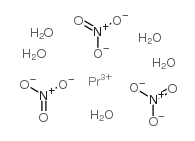14483-17-1
| Name | praseodymium nitrate |
|---|---|
| Synonyms |
praseodymium(3+),trinitrate,pentahydrate
Praseodymium(III) nitrate pentahydrate |
| Boiling Point | 83ºC at 760mmHg |
|---|---|
| Molecular Formula | H10N3O14Pr |
| Molecular Weight | 416.99900 |
| Exact Mass | 416.92400 |
| PSA | 252.79000 |
| LogP | 0.53080 |
| Appearance | Crystalline Powder | Green |
| Vapour Pressure | 49.8mmHg at 25°C |
Synonym:None Section 2 - COMPOSITION, INFORMATION ON INGREDIENTS
Risk Phrases: 8 Section 3 - HAZARDS IDENTIFICATION EMERGENCY OVERVIEW
Contact with combustible material may cause fire.Hygroscopic (absorbs moisture from the air).The toxicological properties of this material have not been fully investigated. Potential Health Effects Eye: May cause eye irritation. Skin: May cause skin irritation. Ingestion: May cause gastrointestinal irritation with nausea, vomiting and diarrhea. The toxicological properties of this substance have not been fully investigated. Inhalation: May cause respiratory tract irritation. The toxicological properties of this substance have not been fully investigated. Chronic: No information found. Section 4 - FIRST AID MEASURES Eyes: Flush eyes with plenty of water for at least 15 minutes, occasionally lifting the upper and lower eyelids. Get medical aid. Skin: Get medical aid. Flush skin with plenty of water for at least 15 minutes while removing contaminated clothing and shoes. Wash clothing before reuse. Ingestion: Never give anything by mouth to an unconscious person. Get medical aid. Do NOT induce vomiting. If conscious and alert, rinse mouth and drink 2-4 cupfuls of milk or water. Inhalation: Remove from exposure and move to fresh air immediately. If not breathing, give artificial respiration. If breathing is difficult, give oxygen. Get medical aid. Notes to Physician: Section 5 - FIRE FIGHTING MEASURES General Information: As in any fire, wear a self-contained breathing apparatus in pressure-demand, MSHA/NIOSH (approved or equivalent), and full protective gear. Strong oxidizer. Contact with other material may cause fire. During a fire, irritating and highly toxic gases may be generated by thermal decomposition or combustion. Use water with caution and in flooding amounts. Vapors may be heavier than air. They can spread along the ground and collect in low or confined areas. Extinguishing Media: Use agent most appropriate to extinguish fire. Do NOT get water inside containers. Contact professional fire-fighters immediately. Use water spray, dry chemical, carbon dioxide, or appropriate foam. Section 6 - ACCIDENTAL RELEASE MEASURES General Information: Use proper personal protective equipment as indicated in Section 8. Spills/Leaks: Clean up spills immediately, observing precautions in the Protective Equipment section. Avoid generating dusty conditions. Remove all sources of ignition. Provide ventilation. In case of spill, sweep up solid or absorb liquid with inert material, then place into a biohazard container. Wear protective equipment. Do not get water inside containers. Section 7 - HANDLING and STORAGE Handling: Wash thoroughly after handling. Use with adequate ventilation. Minimize dust generation and accumulation. Avoid contact with eyes, skin, and clothing. Keep container tightly closed. Avoid contact with clothing and other combustible materials. Avoid ingestion and inhalation. Do not allow contact with water. Keep from contact with moist air and steam. Storage: Keep away from heat, sparks, and flame. Do not store near combustible materials. Store in a tightly closed container. Store in a cool, dry, well-ventilated area away from incompatible substances. Store protected from moisture. Section 8 - EXPOSURE CONTROLS, PERSONAL PROTECTION Engineering Controls: Facilities storing or utilizing this material should be equipped with an eyewash facility and a safety shower. Use adequate ventilation to keep airborne concentrations low. Exposure Limits CAS# 14483-17-1: Personal Protective Equipment Eyes: Wear appropriate protective eyeglasses or chemical safety goggles as described by OSHA's eye and face protection regulations in 29 CFR 1910.133 or European Standard EN166. Skin: Wear appropriate protective gloves to prevent skin exposure. Clothing: Wear a chemical apron. Wear appropriate protective clothing to prevent skin exposure. Respirators: Wear a NIOSH/MSHA or European Standard EN 149 approved full-facepiece airline respirator in the positive pressure mode with emergency escape provisions. Section 9 - PHYSICAL AND CHEMICAL PROPERTIES Physical State: Crystals Color: dull lime green - green Odor: Not available. pH: Not available. Vapor Pressure: Not available. Viscosity: Not available. Boiling Point: Not available. Freezing/Melting Point: Not available. Autoignition Temperature: Not applicable. Flash Point: Not applicable. Explosion Limits, lower: Not available. Explosion Limits, upper: Not available. Decomposition Temperature: Solubility in water: Specific Gravity/Density: Molecular Formula: N3O9Pr.5H2O Molecular Weight: 416.9894 Section 10 - STABILITY AND REACTIVITY Chemical Stability: Stable at room temperature in closed containers under normal storage and handling conditions. Conditions to Avoid: Incompatible materials, ignition sources, dust generation, moisture, combustible materials, reducing agents. Incompatibilities with Other Materials: Oxidizing agents. Hazardous Decomposition Products: Nitrogen oxides, irritating and toxic fumes and gases, nitrogen oxides (NOx) and ammonia (NH3). Hazardous Polymerization: Has not been reported Section 11 - TOXICOLOGICAL INFORMATION RTECS#: CAS# 14483-17-1 unlisted. LD50/LC50: Not available. Carcinogenicity: Praseodymium(III)-Nitrate Pentahydrate - Not listed by ACGIH, IARC, or NTP. Section 12 - ECOLOGICAL INFORMATION Section 13 - DISPOSAL CONSIDERATIONS Dispose of in a manner consistent with federal, state, and local regulations. Section 14 - TRANSPORT INFORMATION IATA Shipping Name: SILVER NITRATE Hazard Class: 5.1 UN Number: 1493 Packing Group: II IMO Shipping Name: SILVER NITRATE Hazard Class: 5.1 UN Number: 1493 Packing Group: II RID/ADR Shipping Name: SILVER NITRATE Hazard Class: 5.1 UN Number: 1493 Packing group: II Section 15 - REGULATORY INFORMATION European/International Regulations European Labeling in Accordance with EC Directives Hazard Symbols: O Risk Phrases: R 8 Contact with combustible material may cause fire. Safety Phrases: S 17 Keep away from combustible material. WGK (Water Danger/Protection) CAS# 14483-17-1: No information available. Canada None of the chemicals in this product are listed on the DSL/NDSL list. CAS# 14483-17-1 is not listed on Canada's Ingredient Disclosure List. US FEDERAL TSCA CAS# 14483-17-1 is not listed on the TSCA inventory. It is for research and development use only. SECTION 16 - ADDITIONAL INFORMATION N/A |
| Risk Phrases | 8-36/37/38 |
|---|---|
| Safety Phrases | 17-26-36/37/39 |
| RIDADR | UN 1477 |
